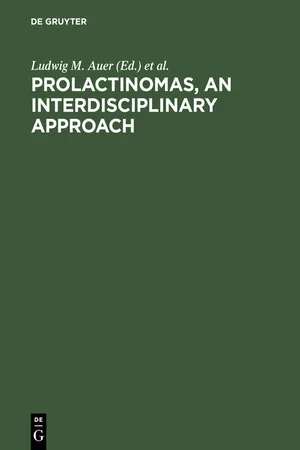
eBook - PDF
Prolactinomas, An interdisciplinary approach
This is a test
- 449 pages
- English
- PDF
- Available on iOS & Android
eBook - PDF
Prolactinomas, An interdisciplinary approach
Book details
Table of contents
Citations
Frequently asked questions
At the moment all of our mobile-responsive ePub books are available to download via the app. Most of our PDFs are also available to download and we're working on making the final remaining ones downloadable now. Learn more here.
Both plans give you full access to the library and all of Perlego’s features. The only differences are the price and subscription period: With the annual plan you’ll save around 30% compared to 12 months on the monthly plan.
We are an online textbook subscription service, where you can get access to an entire online library for less than the price of a single book per month. With over 1 million books across 1000+ topics, we’ve got you covered! Learn more here.
Look out for the read-aloud symbol on your next book to see if you can listen to it. The read-aloud tool reads text aloud for you, highlighting the text as it is being read. You can pause it, speed it up and slow it down. Learn more here.
Yes, you can access Prolactinomas, An interdisciplinary approach by Ludwig M. Auer, Georg Leb, Gerhard Tscherne, Wolfgang Urdl, Gerhard F. Walter, Ludwig M. Auer, Georg Leb, Gerhard Tscherne, Wolfgang Urdl, Gerhard F. Walter in PDF and/or ePUB format, as well as other popular books in Medicine & Medical Theory, Practice & Reference. We have over one million books available in our catalogue for you to explore.
Information
Table of contents
- I Morphology
- Structure and ultrastructure of prolactinomas
- Prolactinomas and mixed adenomas with prolactin cells: an immunohistochemical study of the subcellular localization of hormones
- Immunocytochemical, chemical and nuclear-DNA studies of pituitary tumours
- Hyperplasia of prolactin pituitary cells with or without microadenoma
- Hormone-secretion in cell culture of microprolactinomas, periadenomatous tissue and capsules
- Immunocytochemical ultrastructural and culture characteristics of prolactin-secreting pituitary adenomas
- Immunohistochemical hormone determinations in pituitary adenomas in comparison with endocrinological findings in vivo
- New immunocytochemical observations in prolactinomas
- Problematic divergencies between clinical and immunocytochemical findings in prolactinomas
- Necrosis of prolactinoma cells after bromocriptine treatment
- Spontaneous pituitary lesions and plasma prolactin levels in rats
- II Radiology
- CT-findings in pituitary adenomas
- Comparative study of normal subjects and cases with microadenoma on high-resolution computed tomography
- III Endocrinological and clinical aspects
- Actions of dopamine receptor agonists at the pituitary level
- Dopamine and prolactinomas
- Rhythmometric study of the circadian profile of plasma prolactin in patients with prolactinoma or empty sella syndrome
- Prolactin responses to thyrotropin-releasing hormone, metoclopramide and insulin- induced hypoglycaemia in hyperprolactinaemic and normoprolactinaemic patients
- Evidence for functional impairment of growth hormone secretion in prolactinoma
- THS response to dopamine receptor blockade in women with PRL-secreting microadenoma: long lasting effect of surgical removal
- Prolactin and TSH responses to TRH and domperidone in delayed puberty
- Anterior pituitary function in patients with prolactinomas
- Pituitary adenomas with hyperprolactinaemia in males
- Prolactinoma in multiple endocrine neoplasia type I
- Recurrence of hyperprolactinaemia detected in long-term follow-up of surgically normalised microprolactinomas
- Impairment of pituitary hormone secretion in patients with prolactinoma
- IV Surgical treatment
- The recurrence of pituitary adenoma — a management challenge
- Transsphenoidal operations for prolactinomas
- Prolactinomas: surgical results in 96 cases
- Effect of transsphenoidal surgery on pituitary function
- Transsphenoidal microsurgical treatment of 77 prolactinomas
- Review of 56 prolactin-secreting pituitary adenomas
- The effect of transsphenoidal selective microadenomectomy on patients with prolactinomas
- Surgical results and long-term follow-up in female and male prolactinomas
- Otoliquorrhoea in large prolactinomas. Pathomechanism and surgical management
- Invasive prolactinomas in adolescents
- Residual anterior pituitary function following transsphenoidal resection of pituitary macroadenomas
- Long-term follow-up of prolactinomas. Clinical and morphologic correlation
- Clinicopathological and neurosurgical comparative analysis of operated recurrent prolactinomas and non-secreting chromophobe pituitary adenomas
- V Pharmacotherapy
- New aspects of medical treatment of prolactinomas
- Conservative management of prolactinoma
- Effect of bromocriptine therapy on large prolactinomas
- Macroprolactinomas in male patients: efficiency of treatment with a new dopaminergic drug (CU 32-085-Sandoz), tumor calcification and relative significance of preoperative tumour volume regression as estimated by CT-scan
- Evidence for spontaneous tumour shrinkage in a 45-year-old patient with a 20-year history of untreated microprolactinoma
- The influence of various forms of treatment on serum levels of prolactin, growth hormone and insulin-like growth factors I and II in patients with hyperprolactinaemia and acromegaly
- Persisting partial suppression of growth hormone excess in acromegaly after long-term treatment with bromocriptine
- Medical and surgical treatment of micro- and macroprolactinomas: seven years followup of 65 cases
- VI Aspects of gynecology and obstetrics
- Management of prolactinomas in pregnancy
- Long-term follow-up of hyperprolactinaemia in women
- Prophylactic bromocriptine treatment during pregnancy of women with macroprolactinomas: report of thirteen pregnancies
- Natural regression after pregnancy of a CT visualized microprolactinoma
- Prolactin levels and ovarian function after surgical treatment of prolactinomas
- Pregnancies after treatment of prolactinomas — course and complications
- Psychosomatic findings in patients with elevated prolactin
- List of contributors
- Authors’ index
- Subject index